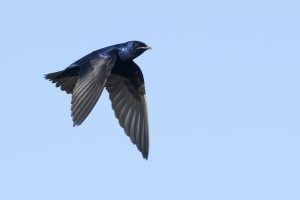Purple Martin Colony Grows in 2021
The Port of Vancouver USA’s purple martin colony had a record-breaking nesting season this year. For the past 10 years, the port has partnered with the Ridgefield National Wildlife Refuge bird experts to increase populations in Southwest Washington and this year, the port’s efforts broke records since it established the colony.
Purple martins are rare migratory birds that winter in South America and move north into the U.S. and Canada in the summer. They have special nesting requirements that include occupying gourds at least 10-feet high which are located in open areas with close proximity to water – making the port’s wetland mitigation bank an ideal location.
The purple martin nesting program started in 2011 with 16 nesting gourds at the Columbia River Wetland Mitigation Bank and increased that amount to 32 in 2019. In fall 2021, volunteers were able to confirm 36 successful hatches, doubling the number of hatchlings in 2020 – a significant increase.
“This year’s habitat success indicates that our colony is consistently drawing purple martins from other areas and this consistency means that the rare birds are thriving here,” said port Environmental Manager Matt Graves.
The port specifically created the habitat area to meet the nesting needs of the purple martins. Sightings of adult banded birds from these other locations were actually seen at our site – from as far away as Ridgefield, Steigerwald Lake and Lane County, Oregon. “This is an encouraging sign that purple martins will visit us again in the future,” Graves continued.
Volunteers with the wildlife refuge, under permit with the U.S. Fish and Wildlife Service, band the chicks within 12 to 21 days of hatching and document their age using a photographic scale. These fascinating birds develop day by day, to the point where their age can be identified from visual indicators such as feathering on the head or back, and wing feather emergence. Banding the birds helps the wildlife refuge and other experts with tracking the birds’ location.
While the nesting season is over for the purple martins, the team is looking forward to seeing even more successful nesting in 2022.
Wildlife success and diversity in natural areas around the port is just one of the many ways the port manages its environmental efforts. Learn more about the port’s environmental programs in its Sustainability Report and the newly released Climate Action Plan.

